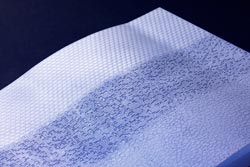Production certainty

Laser-based micro-finished surface.<br>© Fraunhofer IPT<br>
Leather seats, leather steering wheels, and dashboards of wood are accessories frequently included in luxury automobiles. The interior of a medium-priced car looks very similar. The steering wheels exhibit a textured finish that also reminds one of leather.
“Until now, micro-finishes were tooled or etched,” explains Guilherme Mallmann, scientific staff member in the production measurement department of the Fraunhofer Institute for Production Technology IPT in Aachen. To manufacture a texture like this requires several steps at present however, according to the expert, who continues: “With the laser, you can create these finishes more simply and in just one single step.”
During Project Scan4surf over the last two years, a new kind of laser-based micro-finishing was created at IPT in conjunction with industrial partners. The process can be controlled and simultaneously monitored in a single step during production. A modular high-resolution in-line measurement system monitors the pieces during and after micro-finishing. The process is based around an optical sensor that measures depth without making contact. An opto-electronic measurement unit records the spectrum of the interference signal. The measurement beam uses the same beam path as that for the surface finishing. The researchers use low-coherence-length interferometry for this.
“When you throw a pebble into a lake, waves form at the point where the pebble penetrated the water’s surface. If several pebbles fall into the water simultaneously, the waves superpose themselves on one another and propagate. Our technique works in a similar fashion – using light, however. In this instance, the measurement beam travels to the surface of the piece. The object that has been processed reflects the measurement beam and we use this to measure the absolute distance to the piece,” explains Mallmann.
The camera and measurement unit are mounted in a box that is about the size of a small PC. The camera is connected to a computer that processes the data it receives and immediately intercedes in case of an imperfection. This facilitates quality control during production by means of simultaneous computer-assisted adjustment of the process in real time.
“If imperfections arose during processing, they were only detected at the end, until now. If texturing of the surface is too shallow or too deep at a few locations on the surface, for instance because the temperature changed during processing or external influences from other machinery disrupted the accuracy, this is adjusted for immediately,” says Mallmann. At the LASER World of PHOTONICS Trade Fair and Congress Fraunhofer reseachers will be showing a prototype of the system.
The new process creates new opportunities for surface processing and increases flexibility in selecting materials. A big advantage is that the system can be easily retrofitted to existing production facilities. Possible applications include automatic positioning of work pieces and their calibration, automatic process initialization, adaptive fabrication and in-situ quality audits, in repair processes for precision machining, electronics, medical and automobile technology as well as in tool making.
Media Contact
All latest news from the category: Trade Fair News
Newest articles

Parallel Paths: Understanding Malaria Resistance in Chimpanzees and Humans
The closest relatives of humans adapt genetically to habitats and infections Survival of the Fittest: Genetic Adaptations Uncovered in Chimpanzees Görlitz, 10.01.2025. Chimpanzees have genetic adaptations that help them survive…

You are What You Eat—Stanford Study Links Fiber to Anti-Cancer Gene Modulation
The Fiber Gap: A Growing Concern in American Diets Fiber is well known to be an important part of a healthy diet, yet less than 10% of Americans eat the minimum recommended…

Trust Your Gut—RNA-Protein Discovery for Better Immunity
HIRI researchers uncover control mechanisms of polysaccharide utilization in Bacteroides thetaiotaomicron. Researchers at the Helmholtz Institute for RNA-based Infection Research (HIRI) and the Julius-Maximilians-Universität (JMU) in Würzburg have identified a…



